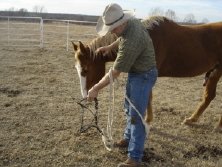|
Haltering and BridlingFor myself, before a horse is really halter/ bridle broke – there are some things I’m looking for.
Haltering First, I want him to put his head down and turn into me slightly
I realize that horses have to be caught, before any of this teaching (putting head down) can take place. However, once I catch a horse and get him haltered, this is one of the basic things I would teach him. It will make it easier the next time.
I use to think that if the horse wouldn’t put his head down, I needed to increase the pressure. Was I ever wrong and I’m sure some horses I handled resented me for that. We often forget that every time we halter and bridle or un-halter our horses, we’re teaching them how to act the next time
With the horses head down and tipped my way, I can easily slip the halter and bridle on. Always mindful not to poke or bump his eye and Never wadding or crunching up his ears. If your horse raises his head or looks away, quietly and calmly direct him to put his head down and toward you again. Then start over. A word about starting over one of the things it took me way to long to learn, was that there’s always room for starting over. This is always a good thing when working with horses (Not such a bad idea for kids/ people either)
Bridling It’s the same principle when bridling a horse. If you’re trying to bridle (or halter) your horse, and his head is up and he is slinging it around, you’re starting off the works with a whole lot of unnecessary tension. You should take the time to get the horse haltering well, before you think too much about bridling him. Before bridling it would be good (with the horse haltered) to get him relaxed about handling his mouth – Rubbing his nose/lips in a slow circular motion, putting your fingers into the space on his bars. When you go to bridle the horse, always try not to bang his teeth with the bit. Horses resent this. Make sure your bridle isn’t to tight before you put it on. Take care not to jab his eye or mash his ears as well. When you adjust the bridle, after it’s on, try to be as smooth and easy as you can. When a horse is haltered/bridled in this way, he will quickly become very agreeable with it.
Un-haltering the horse I didn’t learn this on my own, but heard about it through Bryan Newbert. It is really neat. We have all dealt with these horses – the second they think the halter is off, they whirl away. This can be dangerous. The techniques that I had used to fix this problem before didn’t work well. This little deal is like a gold nugget – worth a lot. as soon as you have the halter unbuckled or untied, leave the horse! It sounds simple, yet it really blows the horses mind. On one that whirls away, when un-haltered, this can leave them looking bewildered.

For questions or comments about haltering and bridling, please contact us.
Return to Training page
|










